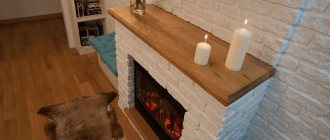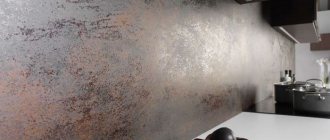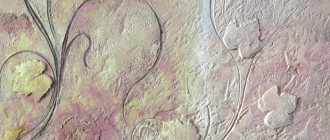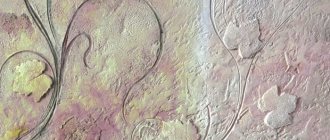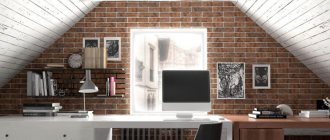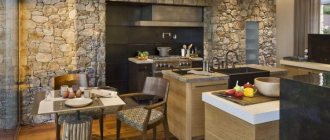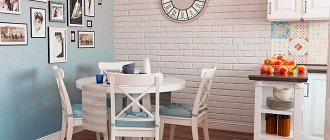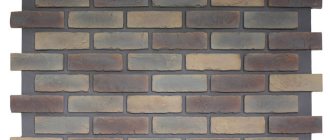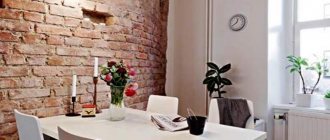It is possible to use decorative brick for interior decoration to give the interior a stone look; this is a kind of immersion in the Middle Ages in one case, if the stone is stylized, or a classic today.
The price of decorative brick for interior decoration is slightly higher than that of traditional wallpaper, but the end result is much better. This interior has become widespread due to the quality of the material, high aesthetics and performance characteristics.
Traditionally, stone is used as a worthy alternative to natural materials, and this is well deserved, since the preparation technology implies 100% safety of the product.
At the same time, the option is quite economical, although somewhat more expensive than wallpaper, but lower than building a structure entirely from brick or purchasing slabs, special tiles from rocks. It also allows you to protect the room from excessive temperature conduction from the outside, and protects the wall itself from excess moisture.
Characteristics and properties
Natural stone is a universal material for construction. Its texture fits perfectly into the style of modern design trends. But such cladding is expensive, so manufacturers produce a wide range of artificial analogues. Outwardly, they look like tiles, the reverse side of which has a smooth surface.
Gypsum tiles “brick” Source roomester.ru
The front side, on the contrary, looks very much like natural stone. In fact, this is a skillful imitation of it, created using uneven relief and correct coloring. All together creates a multifaceted effect. When facing, such tiles help to form a surface that has spatial depth. When creating it, you don’t need to customize every element. It is laid out in random order. Uneven edges help hide the “artificial origin” of the material, so the finished finish looks quite natural.
The module has a smooth back and a raised face Source www.go41.ru
There are two manufacturing options on store shelves: there are individual decorative stone-look tiles for interior decoration, and there are modules that consist of individual elements. They are not joined to form floors like the first ones, but are mounted like tiles. The seams are filled with grout.
Some stones have a convex relief on their front surface. It skillfully imitates brickwork and flagstone paving. Products vary in size and color. With marble coverings, colors come to the fore. Their properties are similar to porcelain stoneware. By using different types of masonry, it is possible to emphasize the natural shade and hide the artificial origin of the material.
Marble types of coatings in the interior Source media.plitkimira.ru
Bathroom decorated with marble stone tiles Source sanplit-online.ru
Advantages
The range of products is quite extensive. If necessary, you can easily recreate a surface lined with any natural stone. Factory-made products cost five or six times less. This helps to make luxury repairs while staying within budget estimates.
Luxury renovation at an affordable price Source www.salvacarro.be
Strength is the main advantage of the material Source bucwar.ru
Any decorative stone-look tile for interior or exterior cladding is durable. Once assembled, the finish cannot be damaged mechanically unless you deliberately hit it with a hammer. The room retains its attractive appearance for at least 20 years without cosmetic repairs. Animals cannot scratch artificial stone with their claws, so choosing it is useful for those who want to save money and not invest in frequent interior renovations. The material does not fade in the sun, and the colors do not fade over time. They do not suffer even from dry cleaning.
Walls decorated with artificial stone Source tbs-kamen.ru
Finishing that can last for several decades Source pmd-stone.ru
See also: Catalog of companies that specialize in arranging gazebos, grill houses and children's playgrounds.
Decorative tiles are easier to lay on a wall or floor than natural stone. After installation, the surface does not look visually “heavy” and “bulky”. There are no risks of warping or shrinkage. The presence of different textures, different colors and shades of finished products allows you to implement different design projects. Typically, artificial stones with relief are used to create accents, cover up defects, and create a decor that unites individual elements of the interior.
Stone-look tiles help to combine individual decorative elements Source vlg.crystile.ru
Flaws
When choosing unusual textures, it is important to take into account their technical features. All decorative wall tiles have different-sized reliefs. When tiling, trimming is sometimes necessary. It can only be done using a grinder. And then a lot of time and effort is spent on polishing the cut edges. If this is not done, sharp edges can cause damage to the finished finish.
Sharp protruding edges Source rostov.moskeram.ru
Any tile is a cold material. In terms of tactile sensations, it is inferior to other types of finishes. The textured surface does not allow furniture to be placed close to the wall; it is difficult to hang paintings, mirrors or photographs on it.
Artificial stone is inferior in tactile sensations to natural stone Source roomester.ru
You cannot cover all the walls in a room with artificial stone. With this finishing option, a person feels as if he is in a dark cave. The space becomes “heavier” and visually becomes smaller. Lightness and airiness disappear. All the time it seems like I went down into a dungeon. Even two walls lined with artificial stone overload the space. It becomes difficult to fit existing furniture in it.
A lot of stone-like tiles in the interior overloads the design Source dekormyhome.ru
Dust constantly accumulates on the terrain. It immediately catches your eye, so you will have to clean the room more often, wiping each stone with a damp cloth. And this takes a lot of time. Handling surfaces with your hands can be hazardous. Experience shows that artificial stone is inconvenient to clean with a vacuum cleaner. Difficult care is a significant drawback.
The presence of two walls decorated with artificial stone makes the space heavier Source izplitki.com
Calculation of dry mixtures
Glue calculation. On average per 1 sq. m. plane when laying concrete stone, 5-6 kg of glue is consumed. In order to calculate the required amount of glue, you need to multiply the number of corner elements in linear meters by a factor of 0.3 (thereby converting linear meters to square meters), then add this value with the number of square meters. m plane. This will give us the total amount of stone in square meters. Next, the resulting value must be multiplied by 6 (the number of kilograms of glue per square meter). Thus, we will obtain the total amount of glue in kilograms for the entire surface to be covered.
Our recommended Perel adhesive for concrete tiles is packaged in 25 kg bags. To calculate the number of bags, you need the total amount of glue in kg. divide by 25. Example: you need to buy glue for 95 sq.m. 95 x 6 (kg) = 570 (kg glue) : 25 (kg/1 bag) = 22.8 bags. Rounding up, we get 23 bags of glue.
Gipsel adhesive consumption for gypsum tiles is 4 kg per meter, packed in 30 kg bags. Example: 95 m x 4 kg = 380 kg/30 (kg per bag) = 12.6 bags, rounded up, we get 13 bags.
Kinds
Despite all the variety of ready-made options, there are only two types of stone-look tiles. The one made from gypsum polymer mass is used for interior decoration. It weighs little, does not tolerate low temperatures well, absorbs moisture from the air well, and then releases it when the climate in the room becomes excessively dry. Its color does not fade under the influence of the sun. There are no toxic substances in the composition, so the use of gypsum stone does not pose a threat to human health.
Gypsum stone is an environmentally friendly type of finishing Source avatars.mds.yandex.net
Porcelain tiles, clinker, cotto, majolica - ceramic stone. Clay is used to make it, the product is fired, after which the technical properties of the material change greatly. The stone becomes dense, durable, with zero moisture absorption. These characteristics make it possible to use ceramic tiles for cladding bathrooms and house facades.
Clinker tiles on the wall Source poiskplitki.ru
The material can have a convex relief or be completely smooth. It may have a matte texture. There is a facing covered with glaze. Recently, tiles with a 3D effect have appeared on sale. Its use significantly improves the aesthetic appearance of the finished surface. Today, such artificial stone is actively used to decorate a fireplace ledge, decorate a niche for placing a video system, highlight a dining area, or create an accent in a bedroom or living room.
Accent wall in the bedroom Source pbs.twimg.com
Features of application
Stone adds luxury to the interior; it can be used to create a monolith and highlight a separate functional area. The stone, lined with a ladder, imitates the torn edge of the wall, looks beautiful. This design technique is often used to decorate two adjacent surfaces or faces perpendicular to each other.
Technique for the correct use of textured finishes Source avatars.mds.yandex.net
Water repellent calculation
On average, 1 liter (or 1 kg, since the density of our hydrophobe is 1000 kg/m3) of water repellent is enough to cover 4 sq.m of stone surface, respectively, to calculate the required amount of water repellent, you need to divide the footage of the stone by 4, you get the number of liters ( kg) hydrophobe. Perel water repellent is sold in canisters of 5 and 10 kg, which means we then divide the number of liters (kg) by 5 or 10 and get the number of canisters of a given volume.
Example: 95 sq.m/4=23.75 liters/5=5 5 liter canisters or 2 10 liter canisters and 1 five liter canister.
Manufacturers
Many companies are engaged in the production of stone-look tiles. Products from Spanish and Italian manufacturers have an impeccable reputation in the market. They offer a wide range, set trends, and constantly present new designs that arouse everyone’s admiration.
Collections of Italian manufacturers form interior design trends Source img.tile.expert
When it comes to re-creating the effect of masonry, designers like to choose products from . Intkam offers a collection of wild stone made of plaster, made in pleasant soft colors. Keramo Marazzi produces skillful imitation of smooth stones.
Artificial slate from Keramo Marazzi Source cdn.keramnn.ru
Reviews about these materials are always positive. Buyers note the presence of a rich assortment that allows them to implement any design projects. Another advantage of this choice is the high quality of the product. This is what ensures the durability of the cladding.
High quality is a distinctive feature of products from European manufacturers Source img.tile.expert
Video description
In this video you will see how to make imitation brickwork for a loft style:
Combination with other interior elements
The stylistic possibilities of brickwork in a room can be maximized through the correct selection of contrast. This may be another finishing material, and other interior elements - furniture, lighting.
Combination with furniture and floor Source roomester.ru
White grout for joints looks harmonious with the traditional red color of the finishing material. The rough, rough surface of the bricks is perfectly complemented by accessories made of glass and metal. In terms of furniture, natural wood always favorably emphasizes a brick wall. You can complement the wall with photographs, posters, drawings and other decorative elements.
Briefly about the main thing
Decorative stone-look tiles are a skillful imitation of natural materials that have an affordable price. With its help, you can create different effects, emphasize the style of the room, and give it a warm, homely, cozy appearance. There are two types of products on sale today: those made from gypsum are more suitable for creating interior decoration for bedrooms and living rooms; those made from clay by firing are ideal for cladding facades, fireplaces, bathrooms, and indoor pools.
Ratings 0
Grout calculation
Grout consumption with a recommended joint width of 1.2 cm-3 cm (depending on the collection) and a thickness of 0.5 tile thickness 4 kg/sq.m. The grout is packed in 25 kg bags.
Example: you need to buy grout for 35 m2 of stone 35 x 4 (kg) = 140 (kg grout): 25 (kg/1 bag) = 5.6 bags. Rounding up, we get 6 bags of grout.
For gypsum tiles, the calculation is similar, consumption is 2.5 kg/sq.m, bags are the same, 25 kg each.
Example: you need to buy grout for 30 m2 of gypsum tiles 30 x 2.5 (kg) = 75 (kg grout): 25 (kg/1 bag) = 3 bags.


